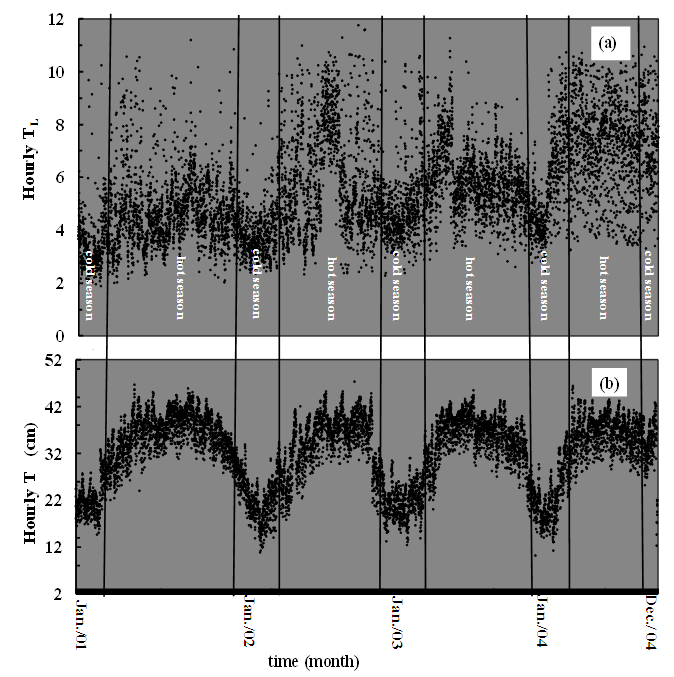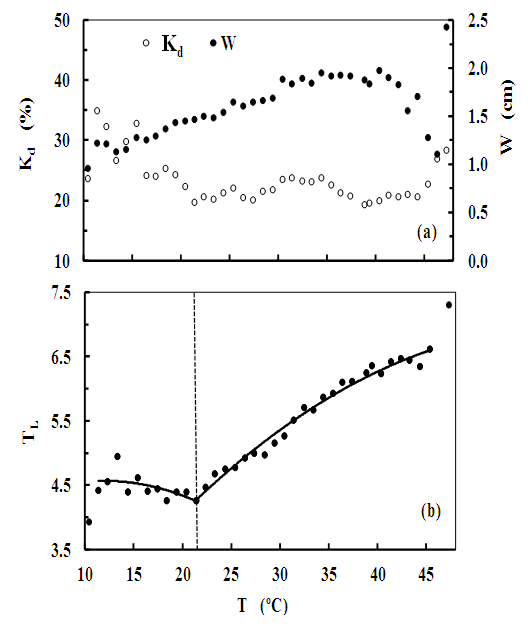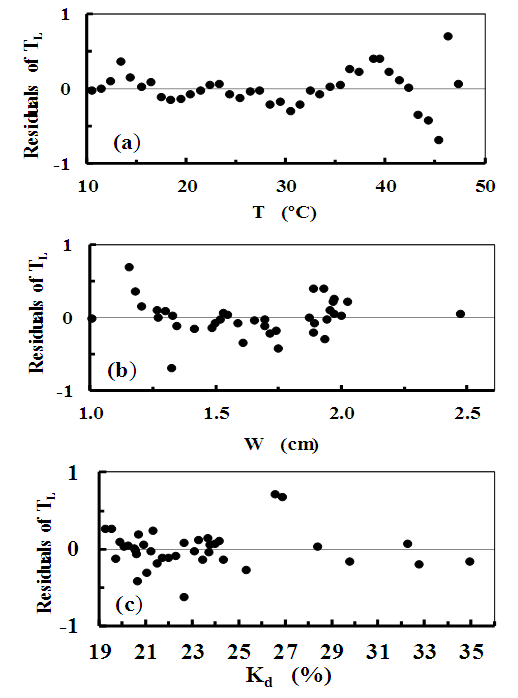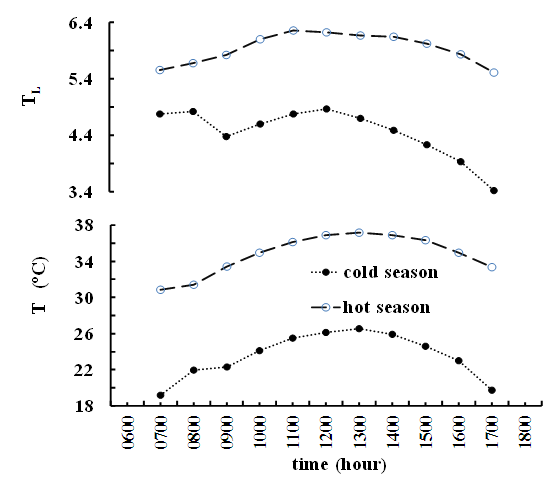| [1] | Lopez G, Batlles FJ, 2004. Estimate of the atmospheric turbidity from three broad-band solar radiation algorithms, a comparative study. Annales Geophysicae 22(8): 2657–2668. |
| [2] | Zakey AS, Abdelwahab MM, Maka PA, 2004. Atmospheric turbidity over Egypt. Atmospheric Environment 38: 1579–1591. |
| [3] | El Shazly SM, 1996. A study of Linke turbidity factor over Qena, Egypt. Advances in Atmospheric Sciences 13, 519–532. |
| [4] | Kasten F, 1980. A simple parameterization of the pyrheliometric formula for determining the Linke turbidity factor. Meteor. Rundsch. 33, 124–127. |
| [5] | El-Wakil M, El-Metwally M, Gueymard C, 2001. Atmospheric turbidity of urban and desert areas of the Nile Basin in the aftermath of Mt. Pinatubo’s eruption. Theor. Appl. Climatol. 68, 89–108. |
| [6] | Dogniaux R, 1975. Variations géographiques et climatiques des expositions énergétiques solaires sur des surfaces acceptrices horizontales et verticales. Rep. B38, IRM, Brussels. |
| [7] | Grenier JC, de la Casinière A, and Cabot T, 1994: A spectral model of Linke’s turbidity factor and its experimental implications. Sol. Energy, 52, 303–314. |
| [8] | Jacovides CP, Varotsos C, Kaltsounides NA, Petrakis M, Lalas DP, 1994. Atmospheric turbidity parameters in the highly polluted site of the Athens basin. Renew. Energy 4: 465–470. |
| [9] | Djafe D, 2013. Estimation of the Ångström coefficient over Ghardaïa city. Revue des Energies Renouvelables 16, 741–748. |
| [10] | Adam ME-N, 2013a. Sensitivity analysis of aerosols’ effect in UVB transmission to solar zenith angle at subtropical location (Qena, Egypt). Atmospheric Environment 71, 311–318. |
| [11] | Adam ME-N, 2014. Atmospheric modulations of the ratio of UVB to broadband solar radiation: effect of ozone, water vapor, and aerosols at Qena, Egypt. Int. J. Climatol. 34, 2477–2488. |
| [12] | Cucumo M, Marinelli V, Oliveta G, 1999. Experimental data of the Linke turbidity factor and estimate of Ångström turbidity coefficient for two Italian localities. Renew. Energy 17, 397–410. |
| [13] | El Hussainy FM, Omran MA, 1998. Analysis and trends of atmospheric turbidity parameters over Cairo. Meteorol. Atmos. Phys. 66: 113–121. |
| [14] | Al-Jamal KS, Ayyash M, Rasas S, Al-Aruri SN, 1987. Atmospheric turbidity in Kuwait. Atmos. Environ. 21: 1855–1859. |
| [15] | Louche A, Maurel M, Simonnot O, Peri G, Iqbal M, 1987. Determination of Ångström’s turbidity coefficient from direct solar irradiance measurements. Solar Energy 38, 89–96. |
| [16] | Gueymard C, 1994. Analysis of monthly average atmospheric precipitable water and turbidity in Canada and the northern United States. Solar Energy 53: 57–71. |
| [17] | Chaâbane M, Masmoudi M, Medhioub K, 2004. Determination of Linke turbidity factor from solar radiation measurement in northern Tunisia. Renewable Energy, 29(13): 2065–2076. |
| [18] | Trabelsi A, Masmoudi M, 2011. An investigation of atmospheric turbidity over Kerkennah Island in Tunisia. Atmos. Res. 101, 22–30. |
| [19] | Adam ME-N, 1995. Studies of Solar Radiation Components Related to Aerosols in the Atmosphere at Qena, Upper Egypt. MSc thesis, South Valley University, Qena, Egypt. |
| [20] | Ahmed ZM, 2008. Empirical models for calculating some solar radiation components at Qena, Upper Egypt using sunshine period measurements. MSc Thesis, South Valley University, Qena, Egypt. |
| [21] | Rahoma UA, Hassan AH, 2010. Estimate of aerosol optical depth using broadband direct normal observations at the highest polluted area in the world. Am. J. Applied Sci. 7: 647–655. doi:10.3844/ajassp.2010.647.655. |
| [22] | Linke F, 1922. Transmissions: Koeffizient und Trübungsfaktor. Beiträge zur Physik der Atmosphäre 10, 91–103. |
| [23] | Mavromatakis F, Franghiadakis Y, 2007. Direct and indirect determination of the Linke turbidity coefficient. Solar Energy 81, 896–903. |
| [24] | Kasten F, 1988: Elimination of the virtual diurnal variation of the Linke turbidity factor. Meteor. Rundsch. 41, 93–94. |
| [25] | WMO (World Meteorological Organization), 1990. Guide to Meteorological Observation Methods. Tn-8, Geneva, Switzerland, Chapter 9. WMO Secretariat, 925–932. |
| [26] | WMO (World Meteorological Organization), 2006. Guide to Meteorological Instruments and Methods of Observation. WMO No. 8, 158–167. |
| [27] | WRC (World Radiation Centre), 1985. Sixth International Pyrheliometer Comparison (IPC VI), 1–18 October, Working Report No. 137, Davos, Switzerland. |
| [28] | WRC (World Radiation Centre), 1995. International Pyrheliometer Comparison (IPC VII), 25 September–13 October, Working Report No. 188, Davos, Switzerland. |
| [29] | Adam ME-N, 2011a. Effect of the atmosphere on UVB radiation reaching the Earth’s surface: Dependence on solar zenith angle. Atmos. and Ocean. Sci. Let. 4: 139–145. |
| [30] | Adam ME-N, 2011b. Effect of macrophysical parameters of clouds on broadband solar radiation (295–2800 nm) at a subtropical location. Atmos. and Ocean. Sci. Let. 4: 180–185. |
| [31] | Adam ME-N, 2013b. Suspended particulates concentration (PM10) under unstable atmospheric conditions over a subtropical urban area (Qena, Egypt). Advances in Meteorology Vol. 2013, Article ID 457181, 10 pages, http://dx.doi.org/10.1155/2013/457181. |
| [32] | Adam ME-N, 2015. Determination of daily total ultraviolet-B in a subtropical region (Upper Egypt): an empirical approach. Atmos. Res. 153: 1–9. |
| [33] | Adam, ME-N, Emad A, Ahmed EA, 2016a. Comparative analysis of cloud effects on ultraviolet-B and broadband solar radiation: Dependence on cloud amount and solar zenith angle. Atmos. Res. 168: 149–157. |
| [34] | Adam ME-N, Emad A, Ahmed EA, 2016b. An assessment of the ratio of ultraviolet-B to broadband solar radiation under all cloud conditions at a subtropical location. Advances in Space Research 57, February 1, 2016, 764–775. |
| [35] | Adam ME-N, El Shazly M, 2007. Attenuation of UVB radiation in the atmosphere: cloud effects at Qena (Egypt). Atmos. Environ. 41: 4856–4864. |
| [36] | Adam ME-N, El Shazly MS, 2008. Diurnal variation of atmospheric stability at Qena (Upper Egypt). Mausam (J. India Meteorol. Serv.) 59, 69–76. |
| [37] | Adam ME-N, Kassem KhO, Ahmed EA, 2013. Statistical relationship between UVB (280–320 nm) and broadband solar radiation (295–2800 nm) at a subtropical location (Qena, Egypt). Atmos. Ocean. Sci. Lett. 6: 173–178. |
| [38] | Kassem KO, 1997. Studies on Atmospheric Turbidity Including the Effect of Some Weather Parameters. MSc Thesis, Faculty of Science at Qena, South Valley University, 212 pp. |
| [39] | Espinosa AJF, Rodriguez MT, Alvarez FF, 2004. Source characterization of fine urban particles by multivariate analysis of trace metal speciation. Atmos. Environ. 38: 873–886. |
| [40] | Chung CE, Ramanathan V, Kim D, Podgorny IA, 2005. Global anthropogenic aerosol direct forcing derived from satellite and ground-based observations. J. Geophys. Res. 110: D24207, doi: 10.1029/2005JD006356. |
| [41] | Karar K, Gupta AK, Kumar A, Biswas AK, Devotta S, 2005. Statistical interpretation of week day/week end differences of ambient gaseous pollutant, vehicular traffic and meteorological parameter in urban region of Kolkatta. J. Environ. Sci. Eng. 47, 164–175. |
| [42] | Bhaskar BV, Vikram M, Mehta VM, 2010. Atmospheric particulate pollutants and their relationship with meteorology in Ahmedabad. Aerosol and Air Quality Research 10, 301–315. doi: 10.4209/aaqr.2009.10.0069. |
| [43] | Stull RB, 2000. Meteorology for Scientists and Engineers. Brooks/Cole. |
| [44] | Rizk HFS, Fareg SA, Ateia AA, El-Bialy A, 1985. Effect of pollutant aerosols on spectral atmospheric transmissivity in Cairo. Environ. Int. 11, 487–492. |
| [45] | Rizk HFS, Soliman SH, El-Bialy A, Ateia AA, 1986. Aerosol optical thickness in Cairo atmosphere. J. Inst. Eng. 66: 45–51. |
| [46] | Willmott CJ, 1981. On the validation of models. Physical Geography 2: 184–194. |
| [47] | Abdelrahman MA, Said SAM, Shuaib AN, 1988. Comparison between atmospheric turbidity coefficients of desert and temperate climates. Solar Energy 40: 219-225. |
| [48] | Mohamed Saad, Amel Trabelsi, Mohamed Masmoudi, Stephane C. Alfaro, 2016. Spatial and temporal variability of the atmospheric turbidity in Tunisia, Journal of Atmospheric and Solar-Terrestrial Physics, Volume 149, Pages 93-99. |
| [49] | El Hussainy FM, 1989. A study of atmospheric turbidity parameters over Cairo. ASRE, Cairo, Egypt, March 19–22, 1(6): 53–63. |
| [50] | Sorin Constantin, Ștefan Constantinescu, David Doxaran, 2017. Long-term analysis of turbidity patterns in Danube Delta coastal area based on MODIS satellite data: Journal of Marine Systems, Volume 170, June 2017: 10-21. |
| [51] | Katz M, Baille A, Mermier M, 1982a. Atmospheric turbidity in a semi-rural site, I: Evaluation and comparison of different atmospheric turbidity coefficients. Solar Energy 28: 323–328. |
| [52] | Katz M, Baille A, Mermier M, 1982b. Atmospheric turbidity in a semi-rural site, II: Influence of climatic parameters. Solar Energy 28: 329–339. |
| [53] | Adam ME-N, 2003. A SODAR-Based Investigation of the Atmospheric Boundary Layer. PhD Thesis, Meteor. Inst. Univ. Freiburg, Germany, No. 8, 259 pp. |
| [54] | El Shazly SM, 1989. Studies of the size distribution of the suspended dust particles in the atmosphere of Qena, Egypt. Mausam (J. India Meteorol. Serv.) 40, 447–450. |
| [55] | El Shazly SM, 1997. A study of atmospheric transparency over Qena, Upper Egypt. Water, Air, and Soil Poll. 94, 259–273. |
| [56] | El Shazly SM, Abdelmageed AM, Hassen GY, Nobi B, 1991. Atmospheric extinction related to aerosol mass concentration and meteorological conditions in the atmosphere of Qena, Egypt. Mausam (J. India Meteorol. Serv.) 42, 376–374. |
| [57] | El Shazly SM, Abdelmageed AM, Adam ME-N, 1997. Solar radiation characteristics at Qena, Egypt. Időjárás: Quart J. Hungarian Meteorol. Service 101, 215–231. |
| [58] | El Hussainy FM. 1986. A Study of Some Aspects of Solar Radiation over Egypt. PhD thesis, Cairo University, Cairo, Egypt. |
| [59] | Guechi A, Chegaar M, Merabet A, 2011. Effect of spectral irradiance distribution on the performance of solar cells. Proceedings of the E-MRS Fall Meeting and Symposium, September 19–23, Warsaw, Poland. |
| [60] | Kasten F, 1966. A new table and approximate formula for relative optical air mass. Arch. Met. Geoph. Biokl. B14:206–223. |
| [61] | Leckner B, 1978. The spectral distribution of solar radiation at the Earth’s surface—Elements of a model. Solar Energy 20, 143–150. |
| [62] | Malik AQ, 2000. A modified method of estimating Ångström’s turbidity coefficient of solar radiation models. Renewable Energy 21(3): 537–552. |
| [63] | Mohamed A, Abdel Kerim FM, Bassily AB, Armia E, Nassary M, 1987. Heavy metal determination in the atmosphere of Qena using spectroscopic technique. Bull. Fac. Sci., Qena, Egypt. |
| [64] | Rahoma UA, Hassan AH, 2012. Determination of atmospheric turbidity and its correlation with climatological parameters. Am. J. Environ. Sci. 8: 597–604. |


















 Abstract
Abstract Reference
Reference Full-Text PDF
Full-Text PDF Full-text HTML
Full-text HTML